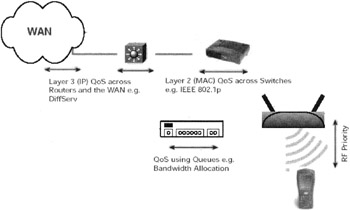Applying QoS
|
| < Day Day Up > |
|
QoS can be applied at different layers of communication and aggregation points, such as networking devices where all traffic from one interface passes through to another, and on a shared medium such as Ethernet or Wi-Fi.

Figure 16.6: This diagram illustrates the different QoS methods that can be applied at different layers of communication and aggregation points.
In most instances, a QoS function gives an end-user or an application precedence or priority over other traffic, and applies in the case of congestion that may occur due to excessive traffic or different data rates and link speeds (e.g. 10 Mbps or 100 Mbps Ethernet, 11 Mbps or 54 Mbps Wi-Fi) that exist in the same network. If there is enough bandwidth for all users and applications, then applying QoS has very little value. But that is unlikely as excessive bandwidth comes at a very high cost. The more likely scenario is that the network's total bandwidth is shared by different users and applications, and thus QoS is required to provide policy enforcement for mission critical applications and/or users that have critical bandwidth requirements.
Different methods of QoS can be applied. The two main categories of QoS are:
QoS via queuing. A network shared by different users (e.g. a revenue-based network, network that is shared by a mixed-use office building, or a HotSpot) is typically implemented with Service Level Agreements (SLA). The SLAs are based on many different factors, such as how much each user group pays for bandwidth. Thus, one or all points of aggregation, such as a switch and some high end routers or policy managers, can allocate different percentages of the total bandwidth to different groups of users through the use of queues. Bandwidth allocation can be further divided and applied to different applications, again using queues.
Application QoS via packet marking. A network or a portion of the network's bandwidth can be shared by different applications. But one or more application may be more latency-sensitive (e.g. voice communication) or more mission-critical (e.g. videoconferencing) than others. In such a case, a priority is assigned to the traffic type by adding the appropriate QoS marking or tags to the network traffic. This method provides higher precedence while the data is passed through points of aggregation (routers, switches, and gateways) and the medium of transfer (Ethernet and/or Wi-Fi).
|
| < Day Day Up > |
|
EAN: 2147483647
Pages: 273